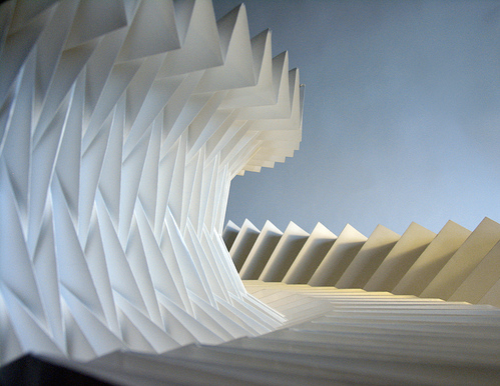Assignment 1: Progress
In thinking about progress, I was immediately attracted to the process of analyzing the progress we have made in order to predict the behavior of things to come.
In thinking about progress, I was immediately attracted to the process of analyzing the progress we have made in order to predict the behavior of things to come.
Many of the 3d models you find in Google 3D Warehouse and Thiniverse will be too complex for folding.
This article describes a technique for reducing the number of polygons in the mesh. It involves downloading a free program called MeshLab (available for OS X and Windows). Follow these steps:
With this technique, I was able to take this model of a hand from the Google 3d Warehouse
and reduce it to this:
Which I was then able to unfold with Pepakura, far more reasonably:
Some seriously gorgeous furniture design by Elisa Strozyk:
Can we all get an appreciative ‘damnnnnn’ for this?
Her site is here. Check it.
Some interesting resources I came upon discussing the creation of curved origami surfaces:
http://www.graficaobscura.com/huffman/index.html
Some examples of and directions for creating basic curved elements
http://graphics.stanford.edu/~niloy/research/folding/folding_sig_08.html
Informative page on modelling the behavior of curved paper or fabric
Robert J Lang talks about his artistic process as an origami artist:
Some examples of origami replacing other soft materials in clothing and fashion:
Trying my hand at folding bluebirds:
Simple instructions: http://www.origami-fun.com/origami-bird.html
http://www.thecoolist.com/papercraft-perfection-10-amazing-master-origami-artists/
I first came across this website and learned about a variety of artists who use paper as their primary medium, along with origami artists, I read about the multitude of techniques within origami.
I found Ingrid Siliakus and Richard Sweeny’s work to be most intriguing.

Ingrid Siliakus makes sculptural forms out of paper. This is a unique form of origami because in a sense it represents a contradiction, as well as a way to take architecture out of its normal context. Architectural structures are typically thought to be concrete, yet these structures are simply made from paper therefore it brings on the question of whether Ingrid’s sculptures are simple mecets of structures, or architectural structures themselves.

Richard Sweeny creates sculptural geometric forms possessed an elegance that one typically does not allocate to paper.
I then decided to look up how to go about making these two types of origami styles, and found these tutorials to be the most helpful:
http://www.youtube.com/embed/dnU6TgFfP
(this type of origami is considered “Kirigami”)
I came across these really beautiful origami vases and vessels by Rebecca Geiseking. I don’t quite know how to explain it, but it almost feels like her work is breathing. You can see her flickr here.
I’m really interested in Oragami tessellations also. I found this handy little basic reference for it here (pay attention to the page numbers, it was intended to be printed and made into a book, so if you are reading it online, the pages are out of order. I’ve been fumbling around with it, but to limited success. Very interested in experimenting with rastering the pre-creasing with the laser cutter.
Here is a nifty little time lapse of a really intense tessellation. There are also a bunch of tutorials on youtube if you poke around.
I’ve always been fascinated by this idea of transition from a flat piece of paper to such dimensional object. I found some inspiring paper art forms. Here is one very complex piece by Richard Sweeney from this website on “100 Extraordinary Examples of Paper Art”.
http://www.webdesignerdepot.com/2009/05/100-extraordinary-examples-of-paper-art/
And here is a very contrasting piece by Jen Stark. This piece doesn’t have complex angular planes as Sweeney’s piece, but rather build from repetition of planes, slightly changing in angle.
<http://www.webdesignerdepot.com/2009/05/100-extraordinary-examples-of-paper-art/> shows many more inspiring artists.
ONLINE INSTRUCTIONS
BOOKS
TOOLS
ARCHIVES OF 3D MODEL
DIGITAL FABRICATION AND ORIGAMI (advanced applications)
OTHER